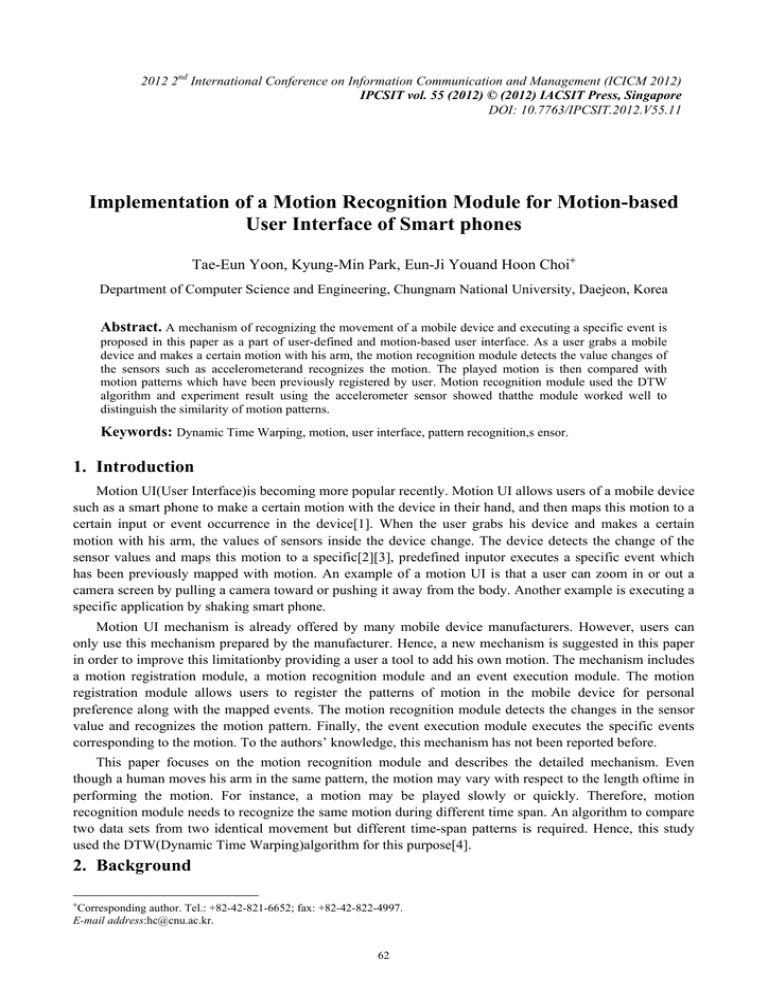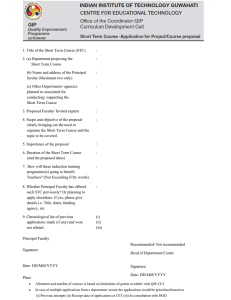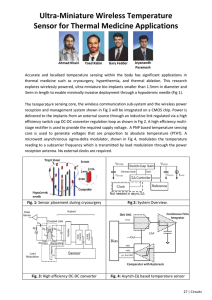Document 13136237
advertisement

2012 2nd International Conference on Information Communication and Management (ICICM 2012) IPCSIT vol. 55 (2012) © (2012) IACSIT Press, Singapore DOI: 10.7763/IPCSIT.2012.V55.11 Implementation of a Motion Recognition Module for Motion-based User Interface of Smart phones Tae-Eun Yoon, Kyung-Min Park, Eun-Ji Youand Hoon Choi+ Department of Computer Science and Engineering, Chungnam National University, Daejeon, Korea Abstract. A mechanism of recognizing the movement of a mobile device and executing a specific event is proposed in this paper as a part of user-defined and motion-based user interface. As a user grabs a mobile device and makes a certain motion with his arm, the motion recognition module detects the value changes of the sensors such as accelerometerand recognizes the motion. The played motion is then compared with motion patterns which have been previously registered by user. Motion recognition module used the DTW algorithm and experiment result using the accelerometer sensor showed thatthe module worked well to distinguish the similarity of motion patterns. Keywords: Dynamic Time Warping, motion, user interface, pattern recognition,s ensor. 1. Introduction Motion UI(User Interface)is becoming more popular recently. Motion UI allows users of a mobile device such as a smart phone to make a certain motion with the device in their hand, and then maps this motion to a certain input or event occurrence in the device[1]. When the user grabs his device and makes a certain motion with his arm, the values of sensors inside the device change. The device detects the change of the sensor values and maps this motion to a specific[2][3], predefined inputor executes a specific event which has been previously mapped with motion. An example of a motion UI is that a user can zoom in or out a camera screen by pulling a camera toward or pushing it away from the body. Another example is executing a specific application by shaking smart phone. Motion UI mechanism is already offered by many mobile device manufacturers. However, users can only use this mechanism prepared by the manufacturer. Hence, a new mechanism is suggested in this paper in order to improve this limitationby providing a user a tool to add his own motion. The mechanism includes a motion registration module, a motion recognition module and an event execution module. The motion registration module allows users to register the patterns of motion in the mobile device for personal preference along with the mapped events. The motion recognition module detects the changes in the sensor value and recognizes the motion pattern. Finally, the event execution module executes the specific events corresponding to the motion. To the authors’ knowledge, this mechanism has not been reported before. This paper focuses on the motion recognition module and describes the detailed mechanism. Even though a human moves his arm in the same pattern, the motion may vary with respect to the length oftime in performing the motion. For instance, a motion may be played slowly or quickly. Therefore, motion recognition module needs to recognize the same motion during different time span. An algorithm to compare two data sets from two identical movement but different time-span patterns is required. Hence, this study used the DTW(Dynamic Time Warping)algorithm for this purpose[4]. 2. Background + Corresponding author. Tel.: +82-42-821-6652; fax: +82-42-822-4997. E-mail address:hc@cnu.ac.kr. 62 2.1. Senssors built in n Android--powered Devices D Androidd-powered mobile m devices have manny internal seensors in general.Gingerrbread,versio on 2.3 of thee Android plaatform, has 11 sensors. Such sensoors measure motion, orieentation, andd various en nvironmentall conditions. Depending on the natuure of sensors, all senso ors except thhe light, preessure, temp perature, andd proximity use u a standardd 3-axis coorrdinate system[5]. Some of o these sensoors are hardw ware-based and a some aree software-baased. Hardw ware-based seensors derivee their data by b directly measuring m phhysical component. Softw ware-based sensors derivve their data from virtuall sensors thatt is a combinnation of onee or more of the hardware-based senssors and softtware-based sensors. s Thee linear acceleeration sensoor and the grravity sensor are examplees of the softw ware-based ssensors. Applicaations and sensors are cloosely related.. For examplle,a proximitty sensor prevvents malfun nction due too a touch of the t face to thhe capacitivee seen duringg a phone caall applicatioon. Also, a light sensor au utomaticallyy controls thee backlight off the device to t provide a clearer screeen. 2.2. And droid Sensoor Subsysteem Androidd sensor subbsystems prrovide data derived from m the sensoors to Andrroid applicattion. Sensorr subsystem operates o in thhe followingg steps. Whenn the Androiid system is booted, Senssor Service is i initialized.. An applicattion that usess a specific sensor createss Sensor Maanager objectt and allocatees that sensor. After that,, Sensor Servvice writes sensor s built in the devicces to queue and receivees the data ffrom queue in i sequence.. Then Sensoor Manager reads r the datta in sequencce. Application that creatted the Sensoor Manager registers thee listener to get g the data and a read the data d using thhe on Sensor Changed meethod. 3. Recoggnition Module M Recognnition modulle recognizees the user's motion thrrough the seensors in thhe mobile device. Afterr recognizingg the user's motion m to be b one of the registered motions, thhe event exeecution modu ule runs thee internal eveents which arre mapped with w the registtered motion n. Some of thhe internal evvents are as follows: fo - executting applicattions / terminnating applications - keypad and touchppad inputs, allready defineed by users - modify fying the connfiguration onn the device or applicatio ons For exeecutingeventss which matches with a motion, the event execuution modulee should be in i the kernell for dispatchhing events and providde that userss can definee events.A way w to applly the patterrn matchingg algorithm annd implemenntation resultt is proposedd in this papeer.Recognitioonmodule coompares the user-defined u d pattern withh the playedd pattern for executingevvent. Patterns are distingguished throuugh the DTW W algorithm m after pre-prrocessingacceelerometer sensor s data of o mobile deevice.DTW algorithm a is used for diistinguishingg similarity between two dynamic d pattterns. 3.1. Pre--processingg of Sensor Data Fig. 1 shows s the grraph drawn with w raw sennsor data of the t linearacccelerometersensor.Since the range off values is wiide, the senssed data musst have pre-pprocessing off two steps so s that DTW W works with h the highestt accuracy annd lower proccessing time. F 1: Data from Fig. fr the lineaaracceleromeeter before pre-processin p ng. First, thhe values of sensor s shouldd have any number n betweeen 0 and 1thhrough the m min-max norm malization. Second, the range of o data shouldd be determiinedsince thee unchanged range doesnnot need the DTW. If thee continuous gradient bassed on vertexx at changingg values on either e side iss over the thrreshold, a ran nge betweenn i determinedd to apply thee DTW. either side is 63 The Figg. 2 shows thhe graph afteer pre-processsing. The ho orizontal axiss is number of generated d data duringg 5 seconds. Fig. 2: Datta from the liinearaccelero ometer after pre-processiing. 3.2. App plying the DTW D DTW iss an algorithm m for measurring similarity between two t patterns which may vvary in time or speed. The Figg. 3 shows thhe matrix forr calculating similarity beetween the tw wo data afterr pre-processsing throughh the DTW. N and M aree the lengthss of the two data. The matrix m has a size of NxM M. Each matrix cells hass value that iss the sum of Euclidean diistance between the two sensed data and a a smalleest value of adjacent a cellss. The value of o final cell(N NxM) is calleed total cost. If two senseed data are thhe same, the total cost is 0. Fiig. 3: DTW matrix. m 3.3. Experiment Samsunng's Galaxy Tab is used forthis expeeriment.The Android Giingerbread pprovides 11 sensors s withh motion, envvironmental, position cateegory. In this experiment,,android appplication takkes two mottion patternss for 5 secoondsand distinguishesthee similarity of the two pattterns.Recognition module is applied to a x-axis value v of acceelerometer seensed data inn ment. the experim 3.4. Resu ults 3.4.1. Same Motions M Whencoomparing thhe same mottion with thhe same inteensity(Experiiment 1)andd the same motion m withh different inttensity(Expeeriment 2), tootal cost abouut each of ex xperiments is calculated. Fig.4 annd Fig.5show wpre-processsed sensed data d of x-axiss ofaccelerom meter when a user shakees the devicee three times with similar intensity. mes-a. Fig. 5: 5 Shaking thhree times-b.. Fig. 4: Shakkingthree tim milar wavefo orms. Althouugh the two ddata waveforrms are veryy Fig.6 reeveals that Fiig.4 and Fig..5 present sim similar to each e other, the total cost is calculaated as 1.86 642168,whichh is greater than 0, beccause of thee differences of amplitudee and frequenncy. 64 F 6:Matchhing between Fig. n two sensed data. Fig.7 annd Fig.8 is a pre-processsed x-axis data of acceleerometer whhen the user drawscircless three timess with differeent intensity. Fig. 7:Draawing circless-a. Figg. 8: Drawingg circles-b. Fig.7 annd Fig.8 show wthat the waaveforms aree similar to eaach other, buut the large ddifferences arre amplitudee and frequenncy. In Fig.77,the data caannot be measured moree accurately.Therefore,inn comparison n to the firstt experiment,,Fig.9 does not n similarly match with two sensed data. d The tottal cost of 2.884857 is an increase i of 1 from total cost c of the firrst experimennt. F 9:Matchhing between Fig. n two sensed data. Despitee difference of the datta, when thhe same mo otion with the same inntensities an nd differentt intensitiesarre compared, two patternns are recognnized as the same due to the t lowest tottal cost. 3.4.2. Differeent Motionss The saame experim ment has been perfoormed for the two different d mootions with the samee intensity(Exxperiment 3)).Fig.10 and Fig.11show the pre-proccessed x-axiss of sensed ddata of the acccelerometerr whena user draws circleesand shakes the device thhree times reespectively. The T total cosst of Fig.10 and a Fig. 11iss a 6.53193666. calculated as Fig. 10:Drawing the circcle-c. Fig. 11:Shaking 1 thhree times-c. 3.4.3. Experim mental Resuults total cost c Exxperiment 1 Experiment 2 Experim ment 3 1.8642168 2.8 84857 6.5319366 Table.1:Tootal cost each h of experimeent. The tottal costof exxperiment 3iis significantly larger th han those offexperiment11 and 2.Con nsidering thee range of norrmalizeddataa(0 to 1), the total cost deerived from the t original data d will be m much higher.. 4. Concllusion This papper proposedd a motion reecognition module m using the DTW alggorithm as a part of user--defined andd motion-baseed user interrface mechannism for moobile devices. The similaarity of patteerns wasdistinguished byy thetotal cosst that is an indicator i of the similarityy of two pattterns.The reesult of the eexperimentprroves thatthee pattern recoognition moddule with DT TW algorithm m works weell in distinguuishing the ssimilarity off two motionn patterns. The tim me complexitty of DTW algorithm ussed in the motion m recognnition module is O(mn)[[6].The timee overheadneeds to be im mproved by adopting ann effective method m for the mobile environmen nt which hass relatively innferior compputational caapability[7].IIn order to improve i the time compllexity, matriix D will bee added to thee global pathh constraintstthat reduces the t seek timee with the matrix[8]. 65 5. Acknowledgement This research was supported by the MKE(The Ministry of Knowledge Economy), Korea, under the ITRC(Information Technology Research Center) support program supervised by the NIPA(National IT Industry Promotion Agency) (NIPA-2012-H0301-12-3005) 6. References [1] S.-J. Cho, E. Choi, W.-C. Bang, J. Yang, J. Cho, E. Ki, J. Sohn, D. Y. Kim and S. Kim. Motion-Understanding Cell Phones for Intelligent User Interaction and Entertainment. HCI. 2006, pp. 684-691. [2] B. Coley, B. M. Jolles, A. Farron, and K. Aminian. Arm position during daily activity. Gait & Posture.2008, vol. 28, no. 4, pp. 581-587. [3] J. Liu, L. Zhong, J. Wickramasuriya, V. Vasudevan.uWave: Accelerometer-based personalized gesture recognition and its applications. Pervasive and Mobile Computing. 2009, vol. 5, no. 6, pp. 657-675. [4] P. Capitani and P. Ciaccia. Warping the time on data streams. Data & Knowledge Engineering. 2007, vol. 62, no. 3, pp. 438-458. [5] Android sensors overview, http://developer.android.com/guide/topics/sensors. [6] M. Mueller. Information Retrieval for Music and Motion. Springer. 2007, pp. 69-84. [7] B. W. Choe, J.-H. Hong, S.-B. Cho. Gesture interface with 3D accelerometer for mobile users. HCI. 2009, pp. 378-383. [8] L. Rabiner, B. H. Juang. Fundamentals of Speech Recognition. Prentice Hall. 1993. Tae-Eun Yoon was born on January 27, 1990, in Cheongju, Korea. She received the B.S. degree in department of computer science and engineering, Chungnam National University, in 2012. She is currently M.S. in department of computer science and engineering, Chungnam National University. Her interests include mobile computing and sensor network. Kyung-Min Park was born on October 24, 1984, in Daejeon, Korea. He received the B.S. degree in department of computer science and engineering, Chungnam National University, in 2010. He is currently M.S. in department of computer science and engineering, Chungnam National University. His research area is the mobile computing, wireless network and embedded software. Eun-Ji You was born on March 10, 1988, in Daejeon, Korea. She received the B.S. degree in department of computer science and engineering from Chungnam National University, Daejeon, Korea in 2011. She currently works as research staff at Mobile Distributed Computing Laboratory in Chungnam National University. Her research interests include Ubiquitous Sensor Network and Mobile computing. Hoon Choi received the B.S.E.E degree in computing engineering from the Seoul National University, Korea in 1983 and the M.S. and Ph.D. degrees in computer science from Duke University in 1990 and 1993, respectively. Before joining the Chungnam National University in 1996, he was a senior member of technical staff of Electronics and Telecommunication Research Institute, Korea since 1983, where he worked on LAN, broadband ISDN and high-speed network system, His research area is the mobile, distributed computing. He has been involved in several research projects on middleware for distributed computing, mobile computing and a software platform of the cellular phone for wireless applications. He is currently interested in mobile computing and the system software for wearable computers. 66




